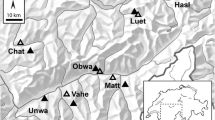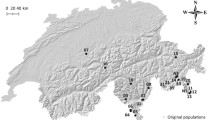Summary
Genetic adaptation implies the shaping of population and species gene pools in response to environmental challenges. The two components of the abiotic land environment are climate and soil, both of which determine much of the evolutionary adaptedness of plants as, besides representing a set of surrounding physical, chemical and sometimes limiting traits, they determine the availability of nutrients and energy, of which they are the immediate source. Ecogeographical distribution of species and ecotypes and different physiological mechanisms and developmental patterns are good evidence of plant adaptedness to soil and climate. However, it is not always easy to determine the underlying genetics of adaptive processes, because 1) environmental factors to which the plants are responding are not always evident and are sometimes too complex, 2) several genes may be involved in the response to a given environmental factor, and 3) the same gene/s may be involved in different adaptive responses. In particular, data on Avena species and temperature as a key environmental factor will be used to illustrate some examples of climatic and edaphic adaptedness. Temperature affects the genetic evolution and geographical distribution of all organisms, and a great deal of evidence indicates that species and populations are genetically adapted to different temperature regimes. Isozymes and other molecular markers have helped in the understanding of the genetic basis of adaptedness. There are many examples of correlation between isozyme and DNA-marker variation and environmental differences. For many population geneticists, isozyme markers are just genetic markers with little or no direct involvement in adaptation. However, metabolic processes are controlled by enzymes, influenced by the environment and used to react in response to it. Evidence that isozymes, and perhaps other molecular polymorphisms, are directly involved in adaptedness will be also presented. Molecular genetic analyses at gene and population levels are opening the ways to a better understanding of plant genetic adaptation.
Similar content being viewed by others
References
Aarssen L.W. & S.M. Burton, 1990. Maternal effects at four levers in Senecio vulgaris (Asteraceae) grown on a soil nutrient gradient. Am J Bot 77: 1231–1240.
Al-Hiyaly S.A.K., T.M. McNeilly & A.D. Bradshaw, 1990. The effect of zinc contamination from electricity pylons. Contrasting patterns of evolution in five grass species. New Phytol 114: 183–190.
Al-Khatib M., T. McNeilly & J.C. Collins, 1993. The potential of selection and breeding for improved salt tolerance in luceme (Medicago sativa L.). Euphytica 65: 43–51.
Allard R.W., 1988. Genetic changes associated with the evolution of adaptedness in cultivated plants and their progenies. J Hered 79: 225–238.
Allard R.W., P. García, L.E. Sáenz de Miera & M. Pérez de la Vega, 1993. Evolution of multilocus structure in Avena hirtula and Avena barbata. Genetics 135: 1125–1139.
Allard R.W., Q. Zhang, M.A. Shagai Maroof & O.M. Mouna, 1992. Evolution of multilocus genetic structure in an experimental barley population. Genetics 1131: 957–969.
Bergmann F. & H.R. Gregorius, 1993. Ecogeographical distribution and thermostability of isocitrate dehydrogenase (IDH) allozymes in European silver Fir (Abies alba). Biochem Syst Ecol 21: 5–605.
Bradshaw A.D., 1965. Evolutionary significance of phenotypic plasticity in plants. Adv Genet 13: 115–153.
Burke J.J., 1990. High temperature stress and adaptation in crops. In: R.G. Alscher & J.R. Cummings (Eds). Stress Responses in Plants: Adaptation and acclimatation mechanisms, pp. 295–309. Wiley-Liss, New York.
Burke J.J., J.R. Mahan & J.L. Hatfield, 1988. Crop-specific thermal kinetic windows in relation to wheat and cotton biomass production. Agron J 80: 553–556.
Chalmers K.J., R. Waugh, J. Watters, B.P. Foster, E. Nevo, R.J. Abbott & W. Powell, 1992. Grain isozyme and ribosomal DNA variability in Hordeum spontaneum populations from Israel. Theor Appl Genet 84: 313–322.
Chanway C.P. & F.B. Holl, 1992. Influence of soil biota on Douglasfir (Pseudotsuga menziesii) seedling growth: the role of rhizosphere bacteria. Can J Bot 70: 1025–1031.
Chanway C.P. & L.M. Nelson, 1990. Field and laboratory studies of Triticum aestivum L. inoculated with co-existent growth-promoting Bacillus strains. Soil Biol Biochem 22: 789–795.
Chanway C.P., R. Turkington & F.B. Holl, 1991. Ecological implications of specificity between plants and rhizosphere microorganisms. Adv Ecol Res 21: 121–169.
Cluster P.D. & R.W. Allard, 1995. Evolution of ribosomal DNA (rDNA) genetic structure in colonial Californian populations of Avena barbata. Genetics 139: 941–954.
Davy A.J., S.M. Noble & R.P. Oliver, 1990. Genetic variation and adaptation to flooding in plants. Aqua Bot 38: 91–108.
Dubuc M., L. Lapointe & J.-P. Simon, 1988. Kinetic properties of NADP+-malic enzyme in two populations of the C4 weed species Echinochloa crus-galli (L.) Beauv. (Poaceae) from sites of contrasting climates. Funct Ecol 2: 353–362.
Emery R.N.J., C.C. Chinnappa & J.G. Chmielewski, 1994. Specialization, plant strategies, and phenotypic plasticity in populations of Stellaria longipes along an elevationl gradient. Int J Plant Sci 155: 203–219.
Erskine W., A. Hussain, M. Tahir, A. Bahksh, R.H. Ellis, R.J. Summerfield & E.H. Roberts, 1994. Field evaluation of a model of photothermal flowering responses in a world lentil collection. Theor Appl Genet 88: 423–428.
Funk C.R., F.C. Belanger & J.A. Murphy, 1994. Role of endophytes in grasses used for turf and soil conservation. In: C.W. Bacon & J.F. White (Eds). Biotechnology and Endophytic Fungi of Grasses, pp. 201–209. CRC Press, Boca Raton, Florida.
García P., F.J. Vences, M. Pérez de la Vega & R.W. Allard, 1989. Allelic and genotypic composition of ancestral Spanish and colonial Californian gene pools of Avena barbata: Evolutionary implications. Genetics 122: 687–694.
Graner A., W.F. Ludwig & A.E. Melchinger, 1994. Relationships among European barley germplasm: II. Comparison of RFLP and pedigree data. Crop Sci 34: 1199–1205.
Hällgren J.-E. & G. Oquist, 1990. Adaptations to low temperatures. In: R.G. Alscher & J.R. Cumming (Eds). Stress Response in Plants: Adaptation and acclimation mechanisms, pp. 265–293. Wiley-Liss, New York.
Hedrick P.W. & L. Holden, 1979. Hitch-hiking: An alternative to coadaptation for the barley and slender wild oat examples. Heredity 43: 79–86.
Hoffman A.A. & P.A. Parsons, 1991. Evolutionary genetics and environmental stress. Oxford Sci Publ, Oxford.
Kato K. & H. Yokoyama, 1992. Geographical variation in heading characters among wheat landraces, Triticum aestivum L., and its implication for the adaptability. Theor Appl Genet 84: 259–265.
Macnair M.R., 1991. Why the evolution of resistance to anthropogenic toxins normally involves major gene changes: the limits to natural selection. Genetica 84: 213–219.
McArthur J.V., D.A. Kovacic & M.H. Smith, 1988. Genetic diversity in natural populations of a soil bacterium across a landscape gradient. Proc Natl Acad Sci USA 85: 9621–9624.
McNeilly T., 1990. Selection and breeding for salinity tolerance in crop species. A case for optimism? Acta Oecol 11: 595–610.
Meharg A.A., Q.J. Cumbes & M.R. Macnair, 1993. Pre-adaptation of Yorkshire fog, Holcus lanatus. L. (Poaceae) to arsenate tolerance. Evolution 47: 313–316.
Melchinger A.E., A. Graner, M. Singh & M.A. Messmer, 1994. Relationships among European barley germplasm: I. Genetic diversity among winter and spring cultivars revealed by RFLPs. Crop Sci 34: 1191–1199.
Nevo E., A. Ordentlich, A. Beiles & I. Raskin, 1992. Genetic divergence of heat production within and between the wild progenitor of wheat and barley: evolutionary and agronomical implications. Theor Appl Genet 84: 958–962.
O'Donoughue L.S., E. Souza, S.D. Tanksley & M.E. Sorrells, 1994. Relationships among North American oat cultivars based on restriction fragment length polymorphisms. Crop Sci 34: 1251–1258.
Orr H.A. & J.A. Coyne, 1992. The genetics of adaptation: A reassessment. Am Nat 140: 725–742.
Palta J.W. & G. Simon, 1993. Breeding potential for improvement of freezing stress resistance: Genetic separation of freezing tolerance, freezing avoidance, and capacity to cold acclimate. In: P.H. Li & L. Christersson (Eds). Advances in Plant Cold Hardiness, pp. 299–310. CRC Press, Boca Raton, Florida.
Parsons P.A., 1987. Evolutionary rates under environmental stress. Evol Biol 21: 311–347.
Pérez de la Vega M., P. García & R.W. Allard, 1991. Multilocus genetic structure of ancestral Spanish and colonial Californian populations of Avena barbata. Proc Natl Acad Sci USA 88: 1202–1206.
Pérez de la Vega M., L.E. Sáenz de Miera & R.W. Allard, 1994. Ecogeographical distribution and differentiation of multilocus allelic association in Spanish Avena sativa L. Theor Appl Genet 88: 56–64.
Platenkamp G.A.J., 1990. Phenotypic plasticity and genetic differentiation in the demography of the grass Anthoxanthum odoratum. J Ecol 78: 772–788.
Roberts E., R. Summerfield, R. Ellis & A. Qi, 1993. Adaptation of flowering in crops to climate. Outlook Agric 22: 105–110.
Royo C., A. Rodríguez & I. Romagosa, 1993. Differential adaptation of complete and substituted Triticale. Plant Breeding 111: 113–119.
Saghai-Maroof M.A., R.W. Allard & Q. Zhang, 1990. Genetic diversity and ecogeographical differentiation among ribosomal DNA alleles in wild and cultivated barley. Proc Natl Acad Sci USA 87: 8486–8490.
Shannon M.C., 1985. Principles and strategies in breeding for higher salt tolerance. Plant Soil 89: 227–241.
Shonnard G.C. & P. Gepts, 1994. Genetics of heat tolerance during reproductive development in common bean. Crop Sci 34: 1168–1175.
Simon J.-P., 1979. Adaptation and acclimatation of higher plants at the enzyme level: Latitudinal variations of thermal properties of NAD malate dehydrogenase in Lathyrus japonicus Willd. (Leguminosae). Oecologia 39: 273–287.
Snaydon R.W. & T.M. Davies, 1994. Rapid divergence of plant populations in response to recent changes in soil conditions. Evolution 36: 289–297.
Stettler R.F. & H.D. Bradshaw, 1994. The choice of genetic material for mechanistic studies of adaptation in forest trees. Tree Physiol 14: 781–796.
Turner A.P., 1994. The responses of plant to heavy metals. In: S.M. Ross (Ed). Toxic metals in soil-plant systems, pp. 153–187. John Wiley and Sons, Chichester.
Turner L.B., C.J. Pollock & G.O. Edmeades, 1994. Thermal kinetics of glutathione reductase and their relation to thermotolerance in diverse cultivars in maize. Ann Bot 74: 254–250.
van Tienderen P.H. & J.van der Toorn, 1991a. Genetic differentiation between populations of Plantago lanceolata. I. Local adaptation in three contrasting habitats. J Ecol 79: 27–42.
van Tienderen P.H. & J.van der Toorn, 1991b. Genetic differentiation between populations of Plantago lanceolata. II. Phenotypic selection in a transplant experiment in three contrasting habitats. J Ecol 79: 43–59.
Via S., 1994. The evolution of phenotypic plasticity: What do we really know? In: L.A. Real (Ed). Ecological Genetics, pp. 33–57. Princeton Univ Press, Princeton, New Jersey.
Yamaguchi-Shinozaki K. & K. Shinozaki, 1994. A novel cis-acting element in an Arabidopsis gene is involved in responsiveness to drought, low temperature, or high-salt stress. Plant Cell 6: 251–264.
Author information
Authors and Affiliations
Rights and permissions
About this article
Cite this article
Pérez de la Vega, M. Plant genetic adaptedness to climatic and edaphic environment. Euphytica 92, 27–38 (1996). https://doi.org/10.1007/BF00022825
Issue Date:
DOI: https://doi.org/10.1007/BF00022825




